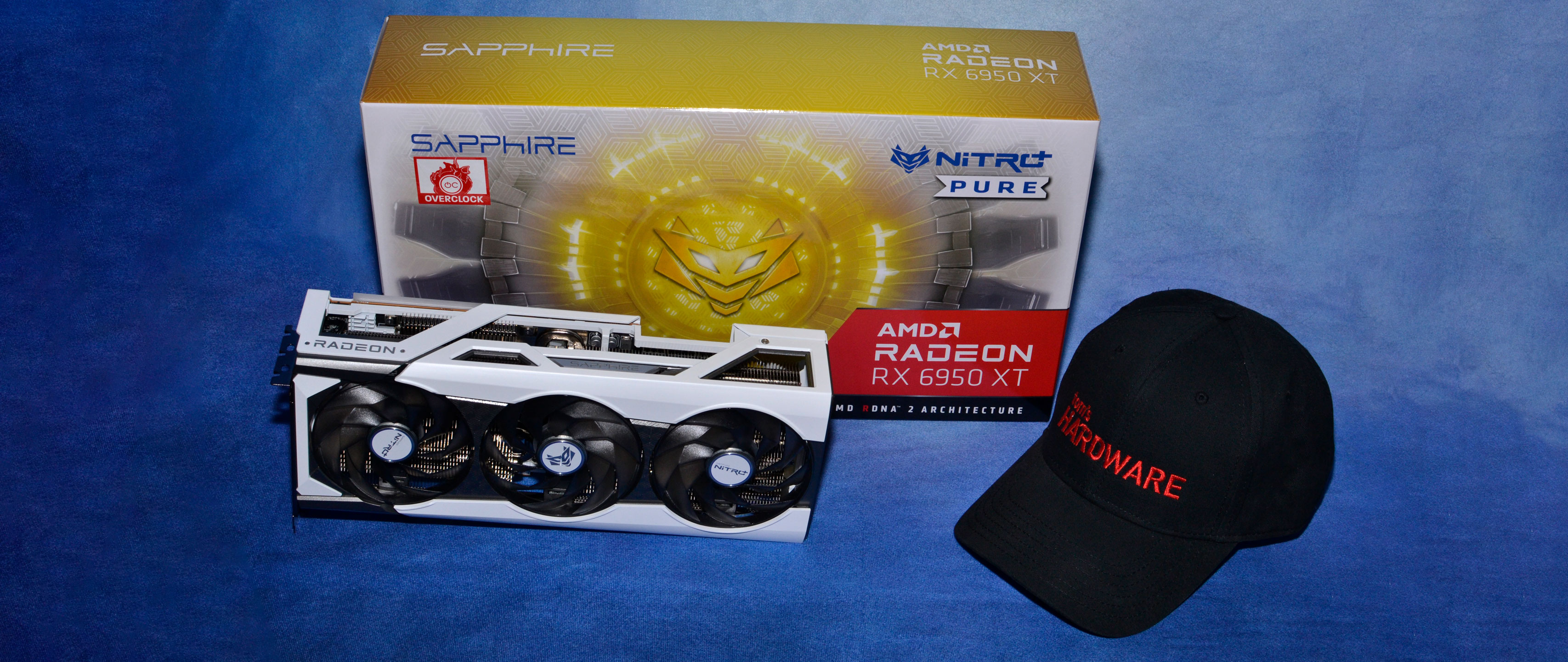Why you can trust Tom's Hardware

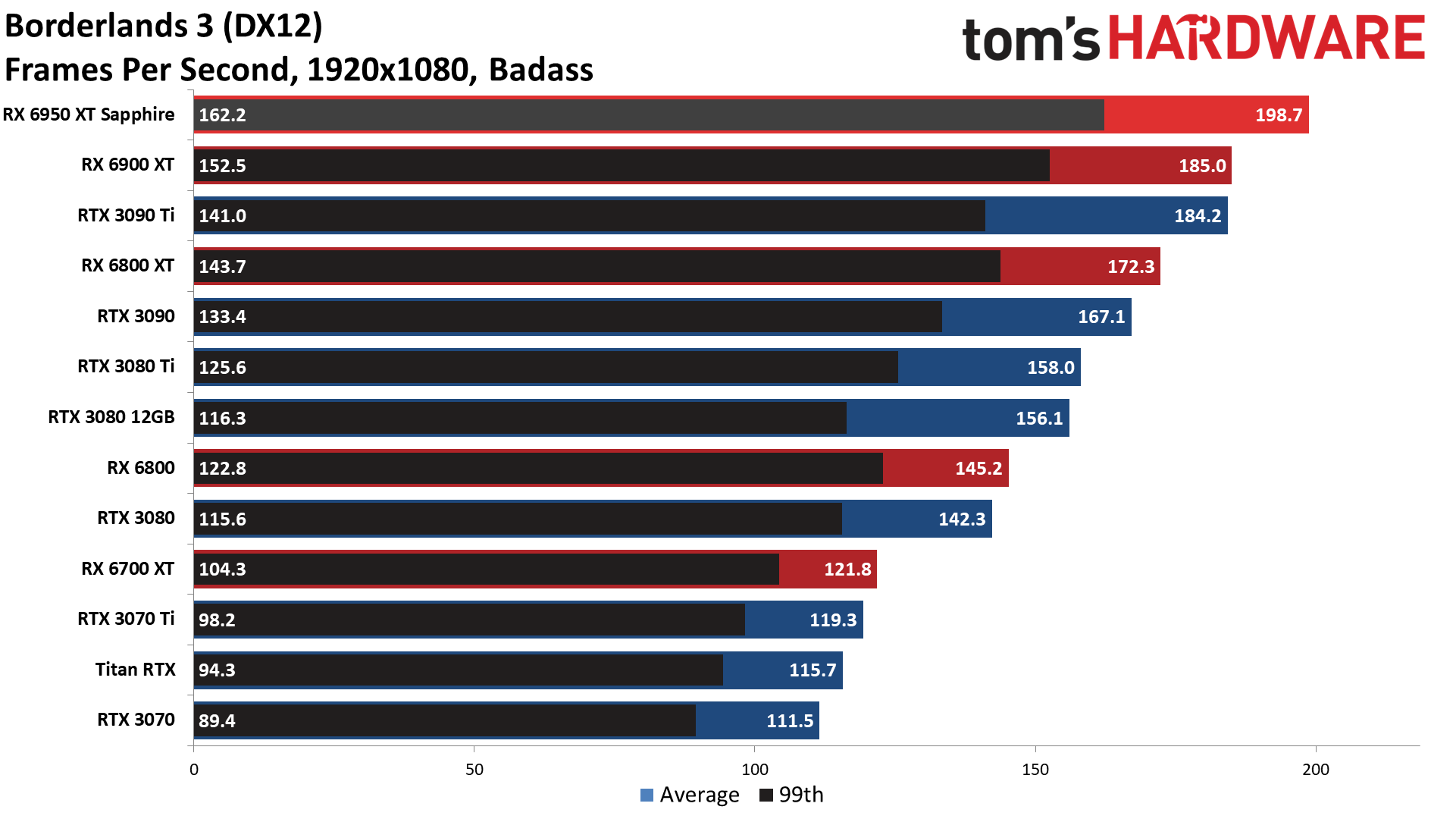
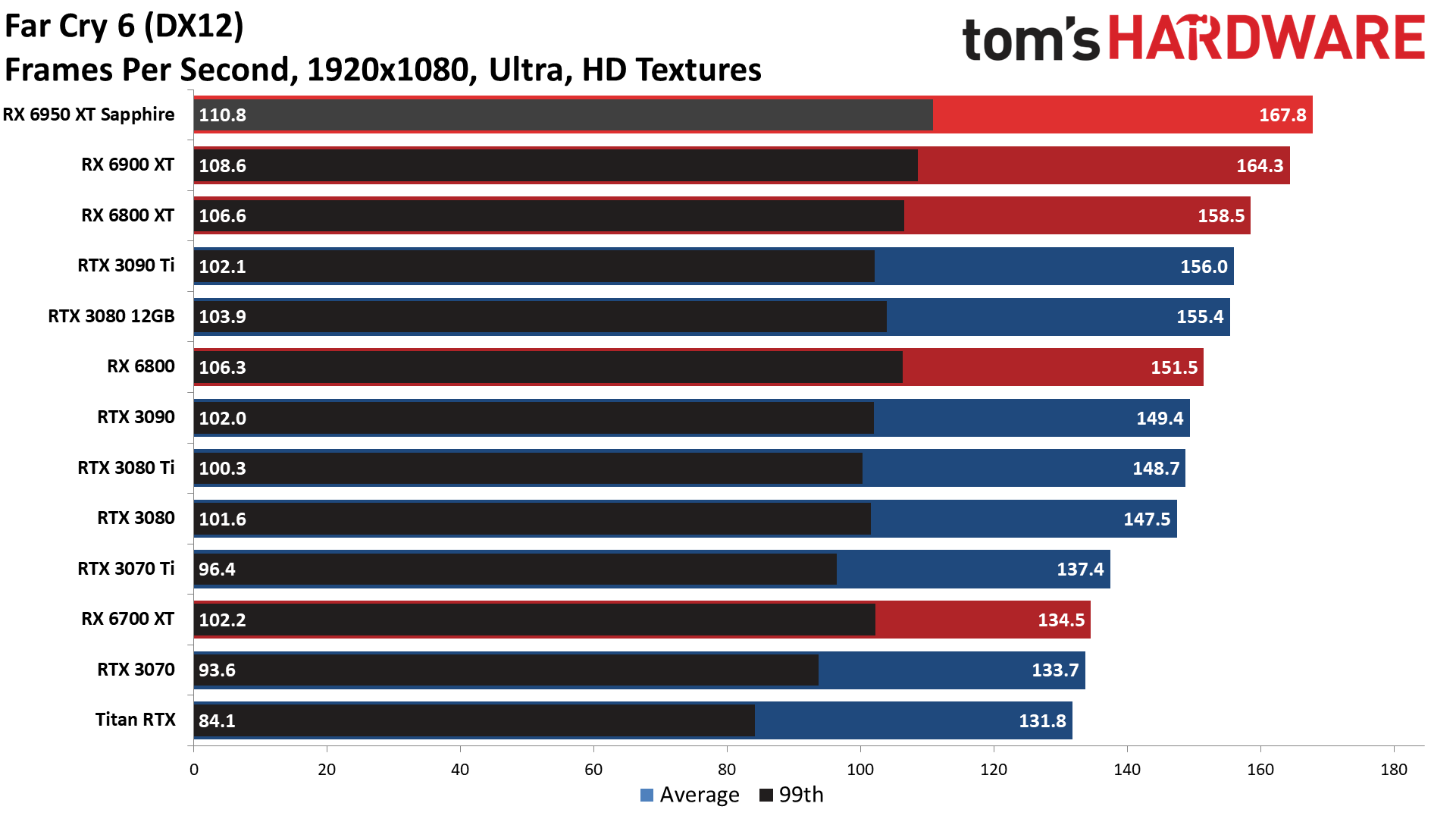
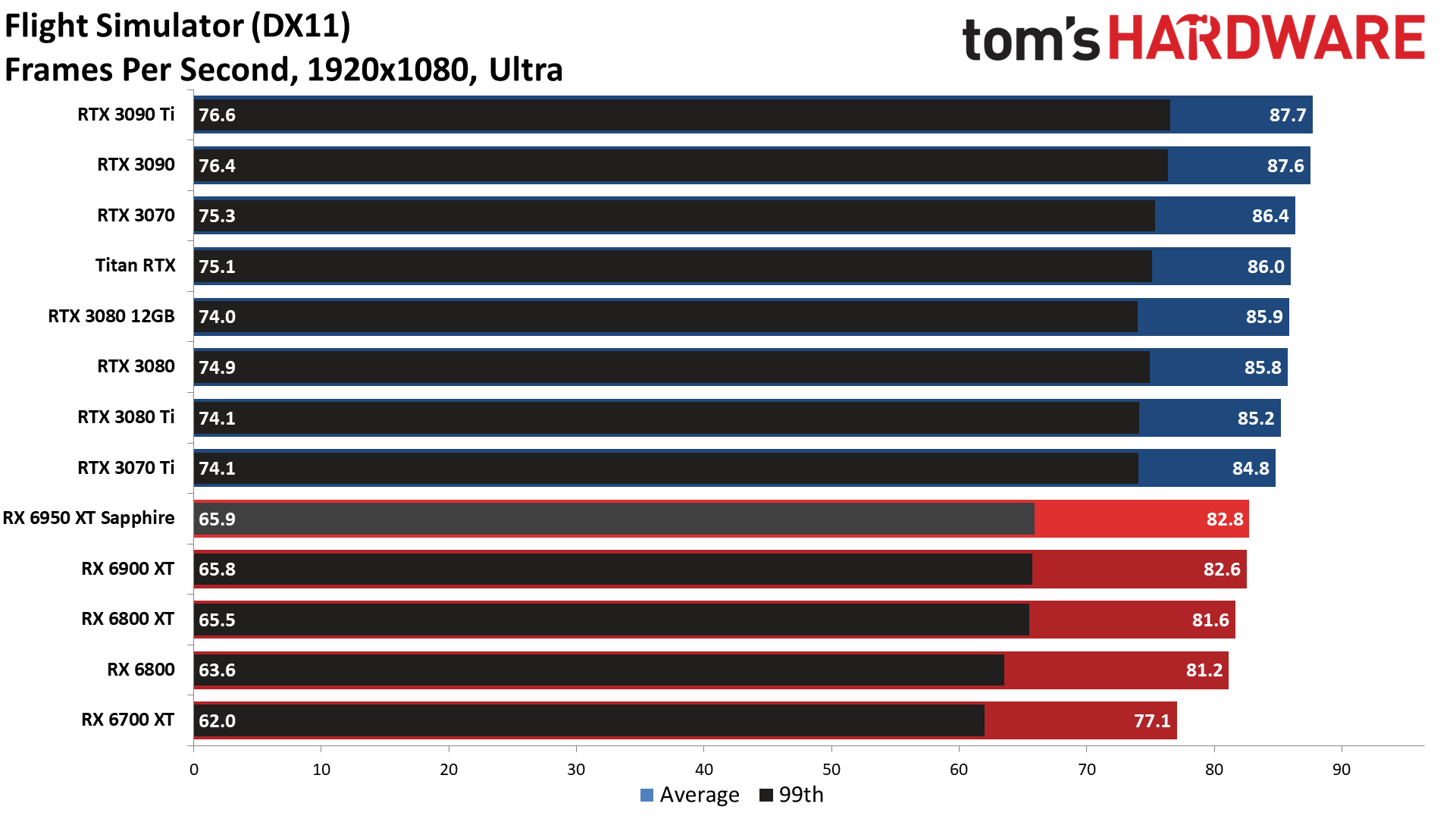
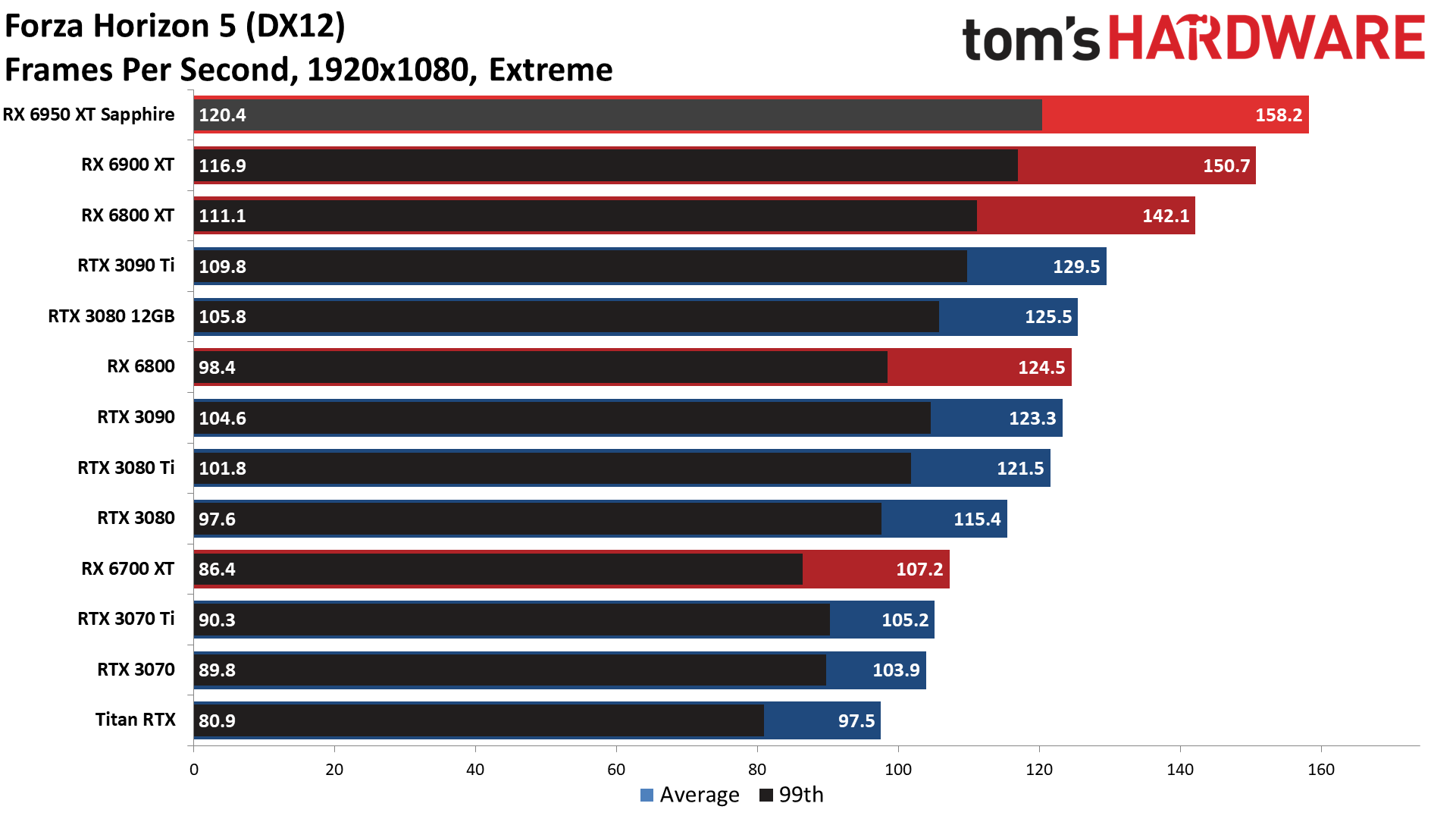
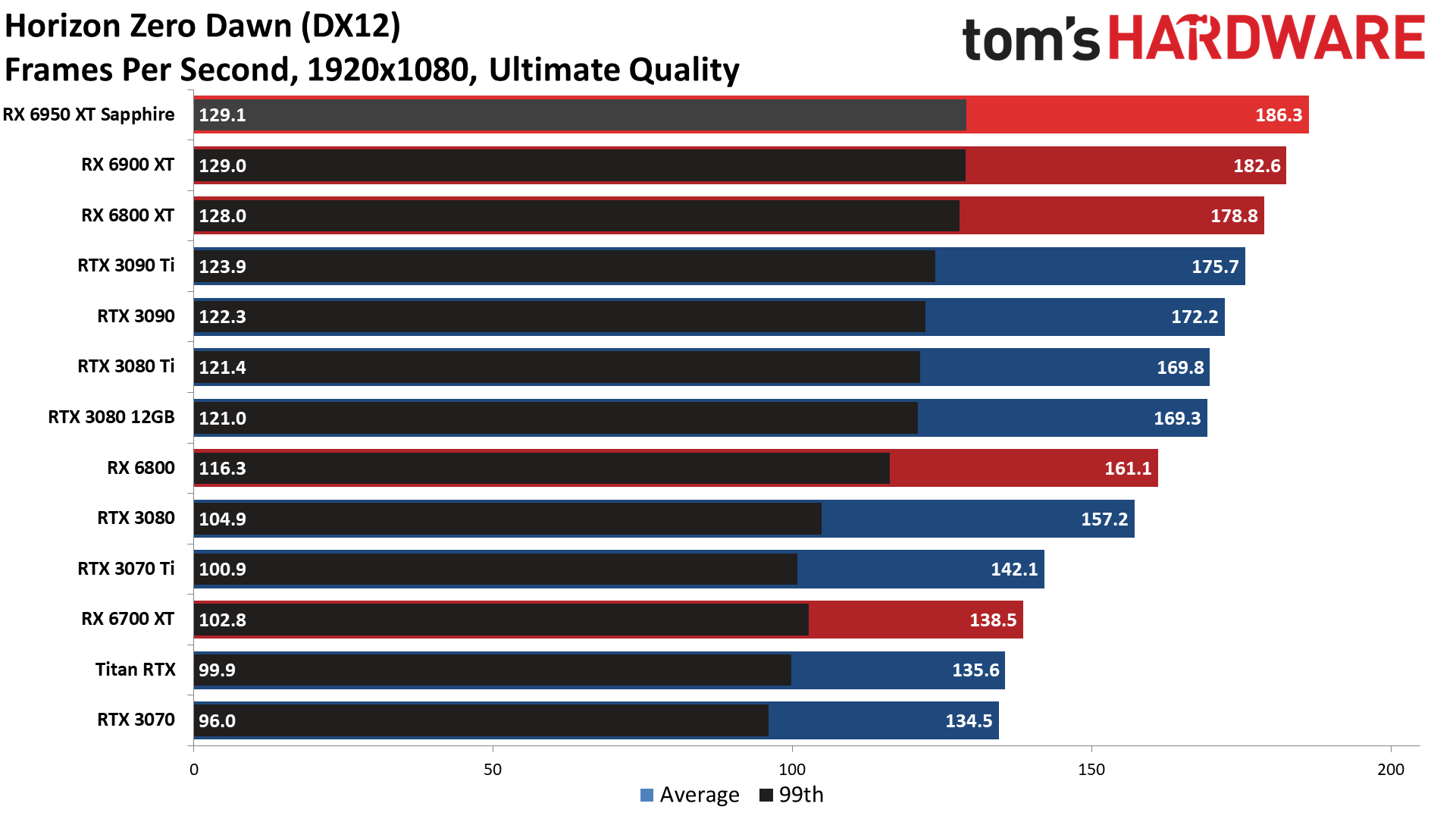
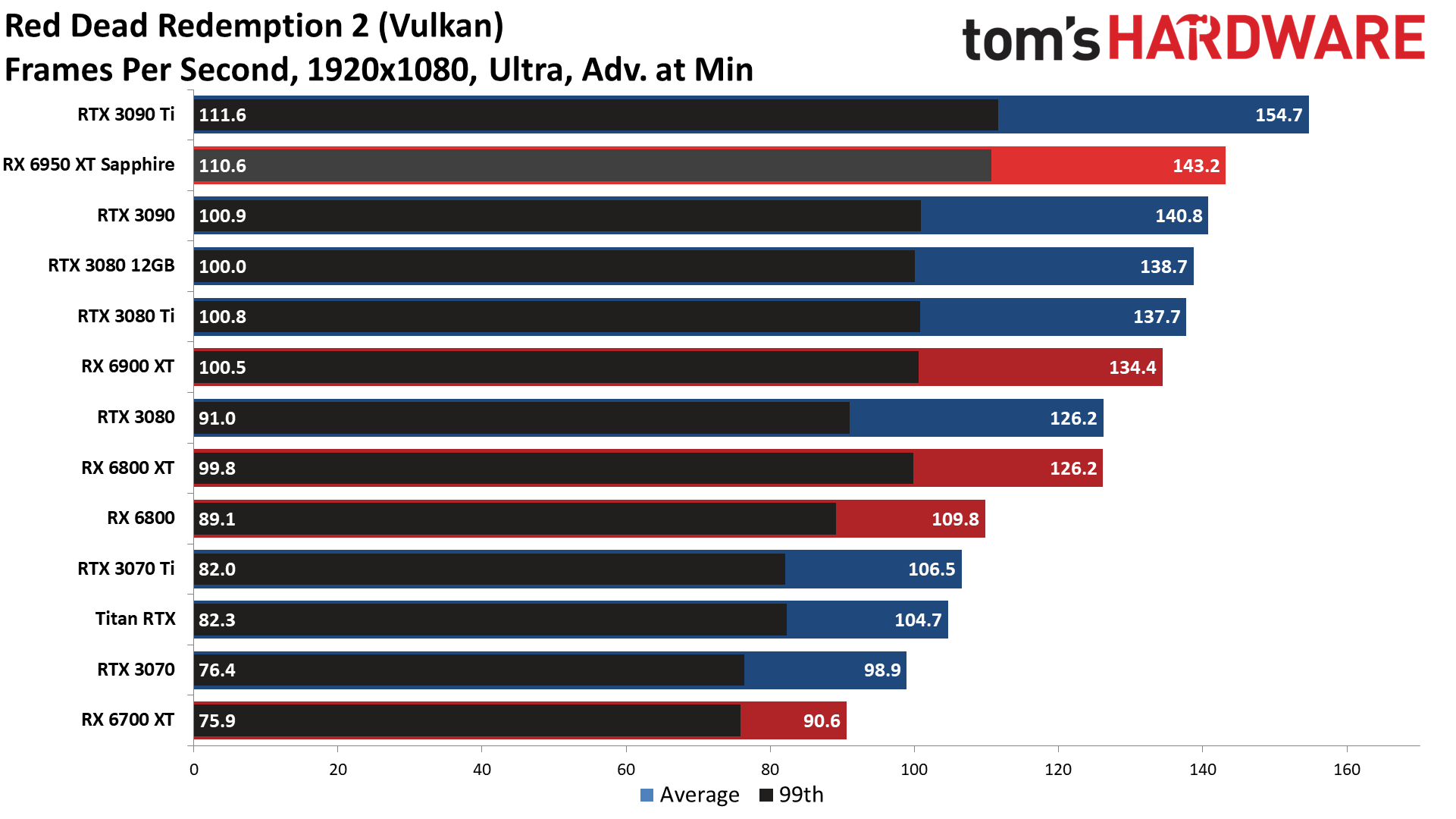
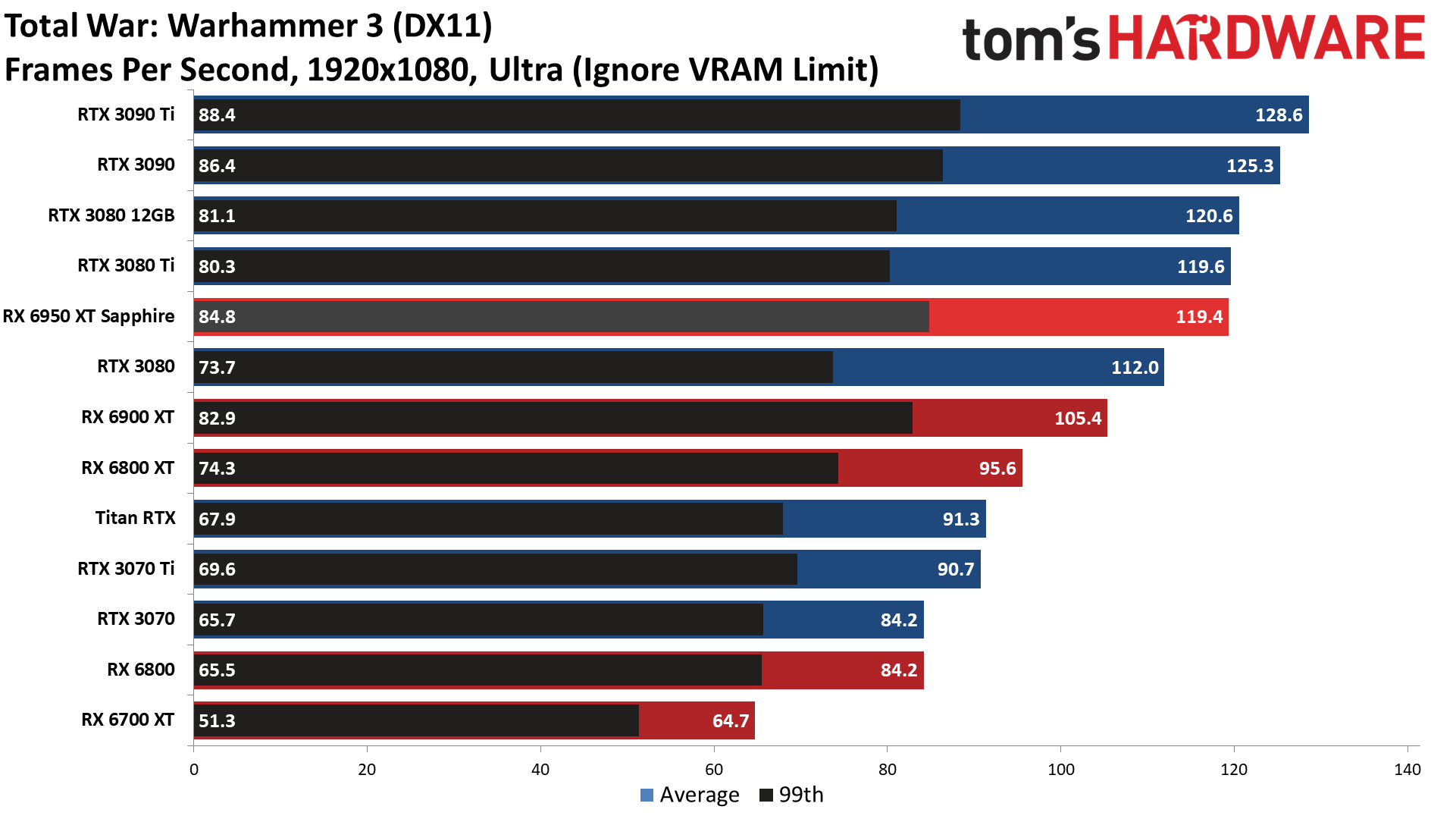
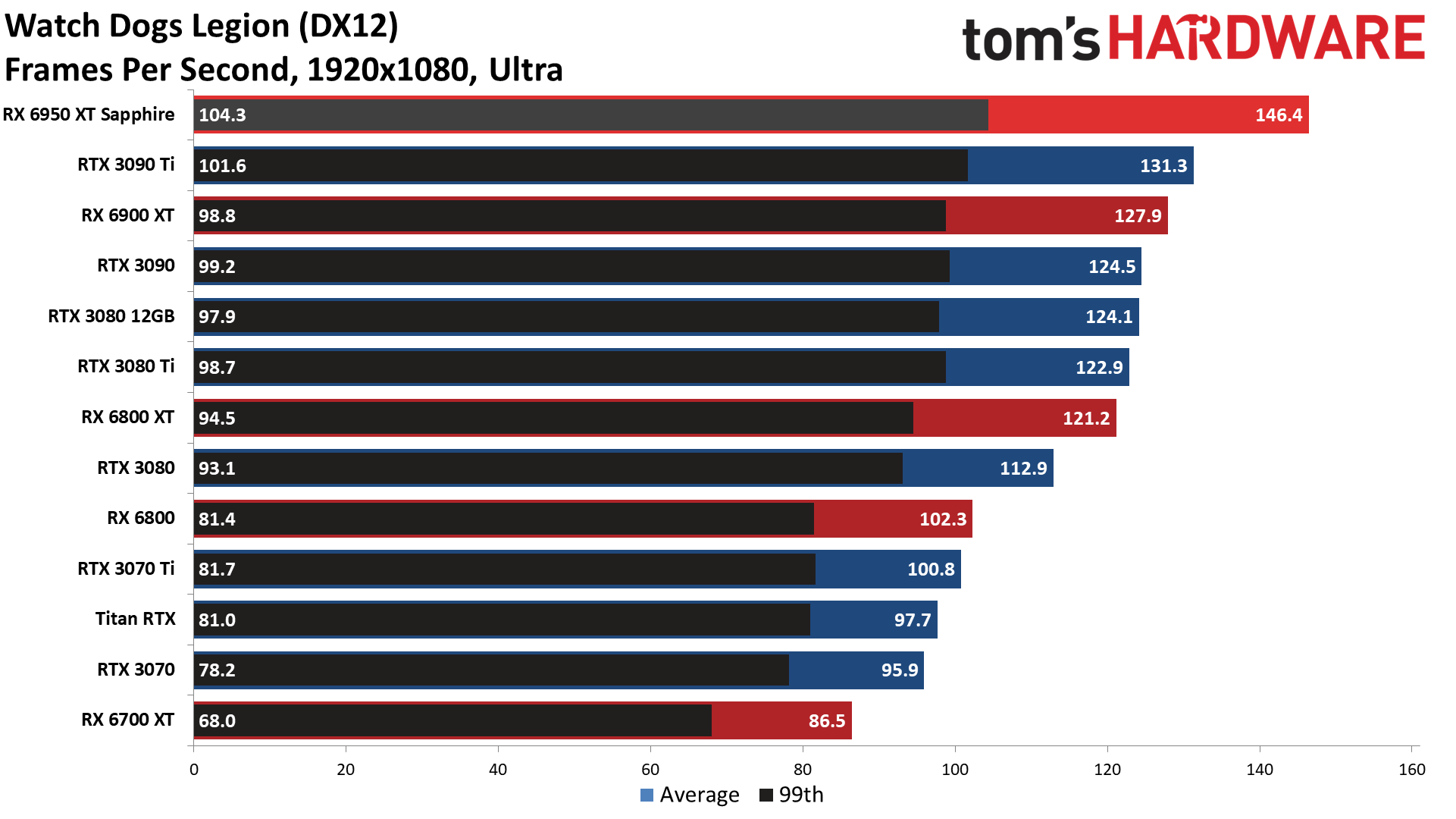
Last and least, at least insofar as resolution is concerned, we have our 1080p testing. Even at ultra settings, CPU bottlenecks become more of a factor and the overall spread from the fastest to the slowest GPU in our charts has shrunk from 89% at 4K to just 46% at 1080p. Meanwhile, AMD gets its biggest lead over Nvidia with the 6950 XT holding a 5% lead over the 3090 Ti and a similar 6% lead over the reference RX 6900 XT.
While some will point to the 1080p 360Hz monitors as being important for professional gamers, also note that of the eight games we tested — none of which are esport titles, granted — only five of the games broke 144 fps on average, and none of the games got above 200 fps. Even if we drop to 1080p medium, only three games broke 200 fps, and none got above 300 fps.
Flipping through the charts, Nvidia still maintained a lead in the same three games as at 1440p ultra. Forza Horizon 5 also skews quite heavily toward AMD, giving the 6950 XT a 22% lead, with Watch Dogs Legion being the only other game to show more than a 10% advantage to AMD — barely, at 11.5%. With most of the other games showing around a 5% difference between the top two cards, there's not much more to be said for the 1080p results.
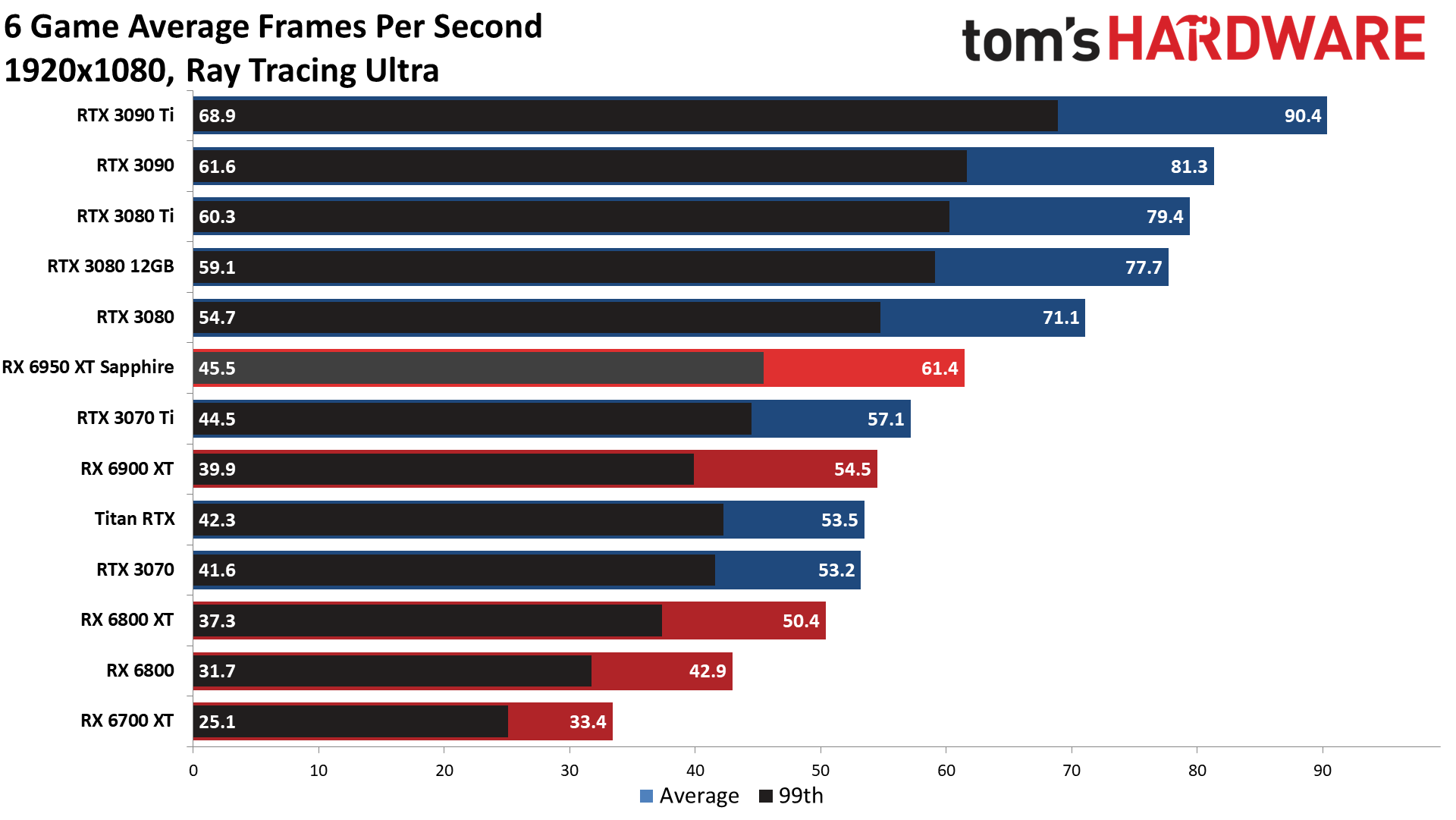
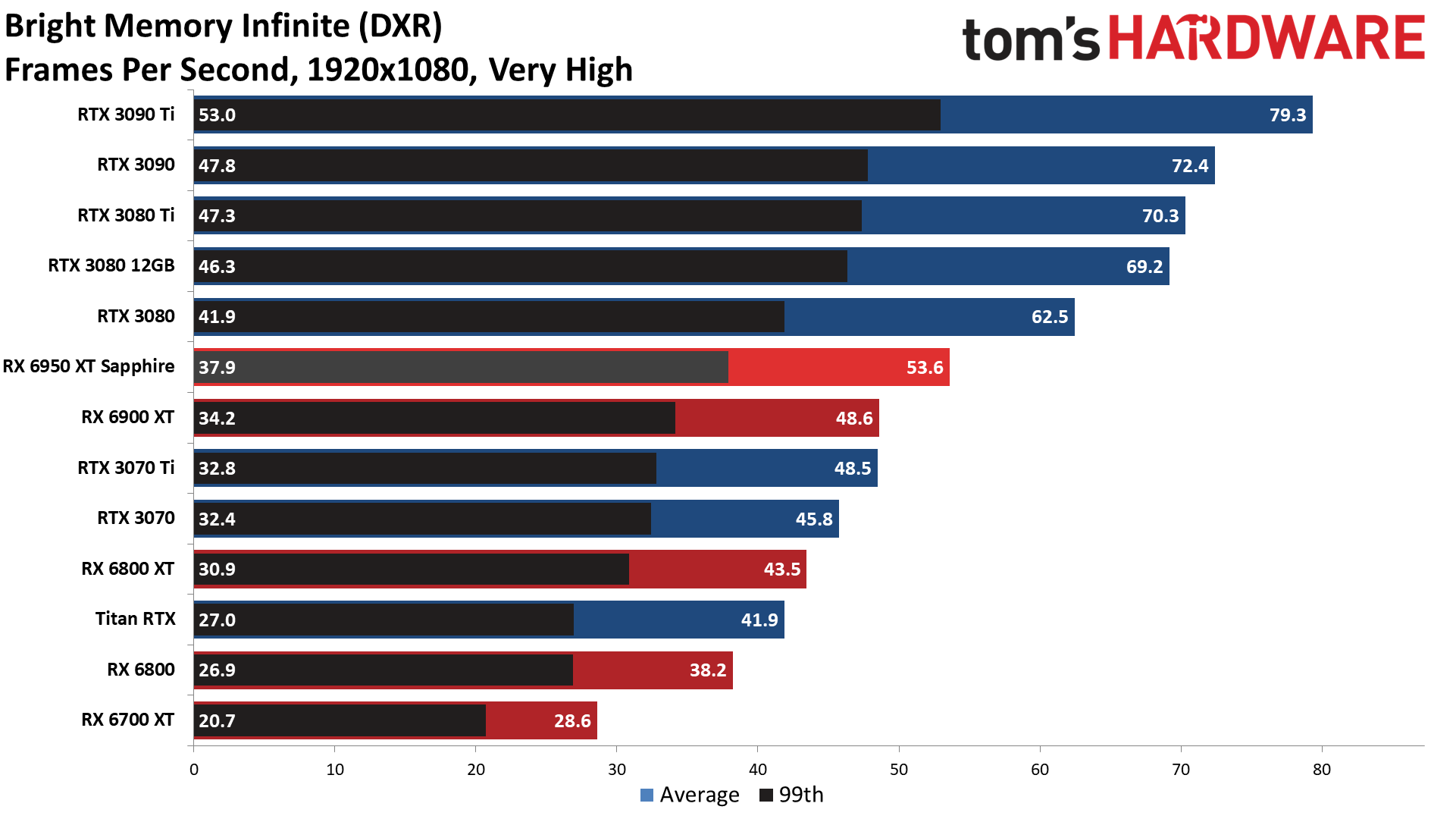
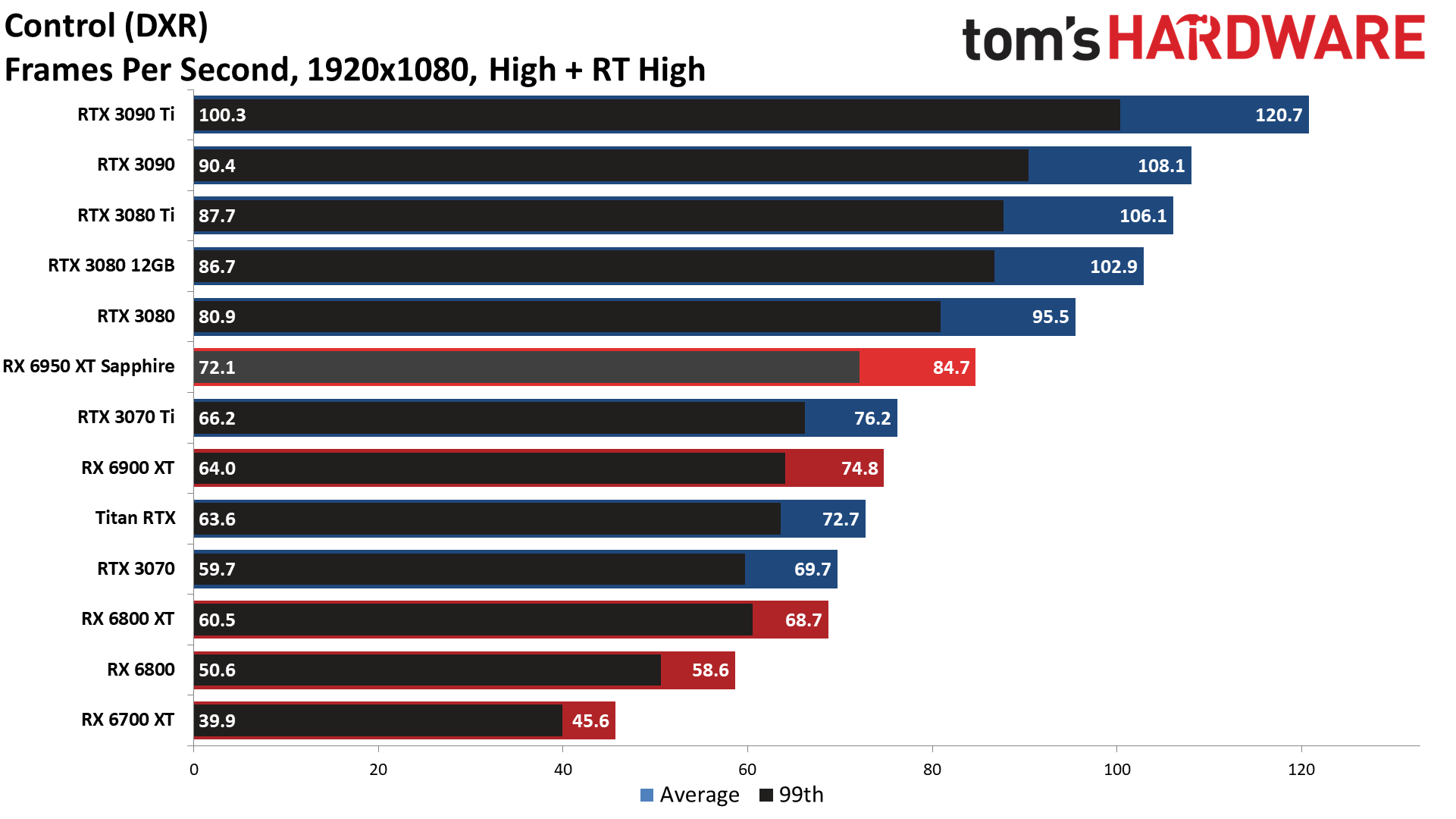
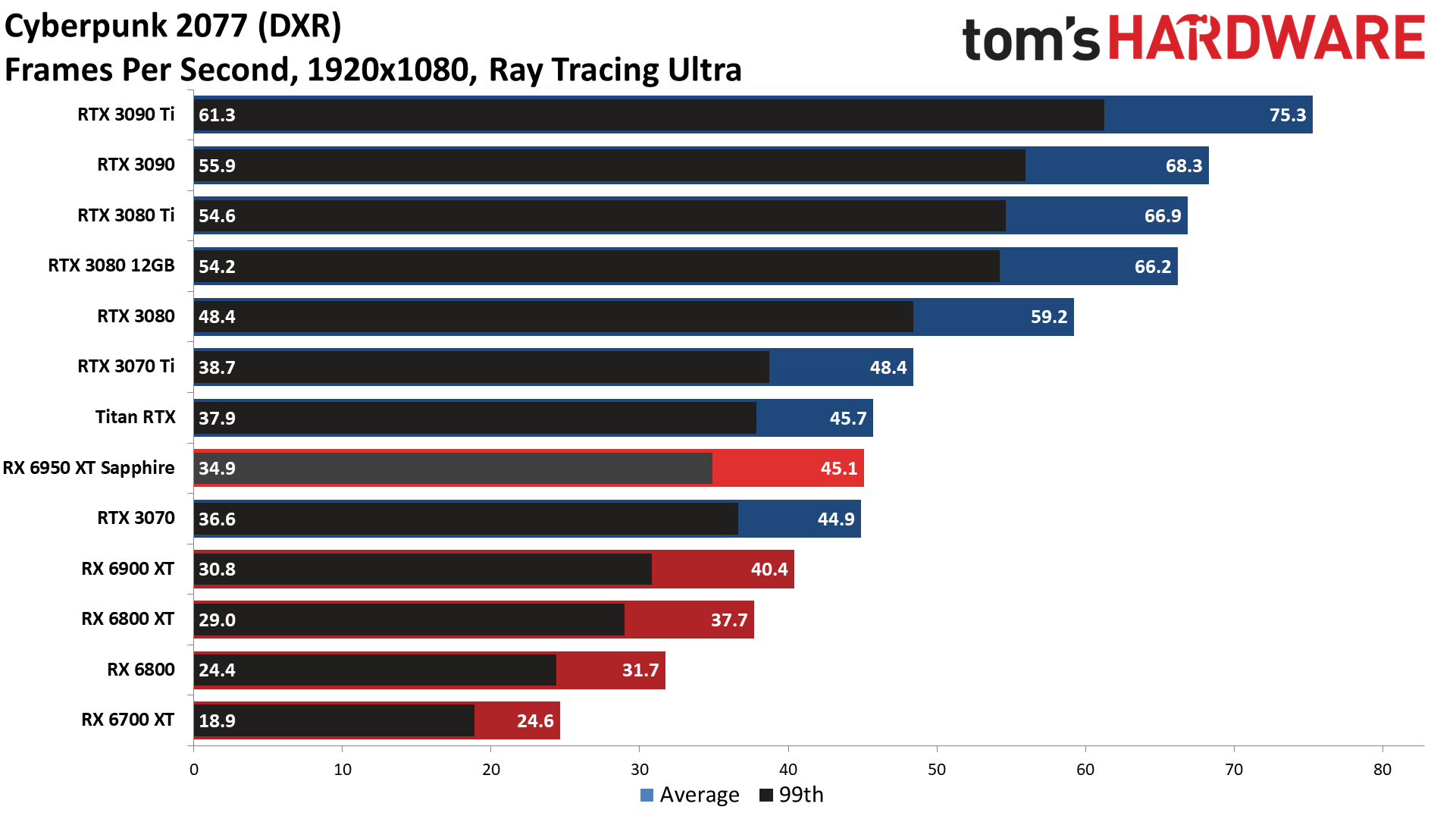
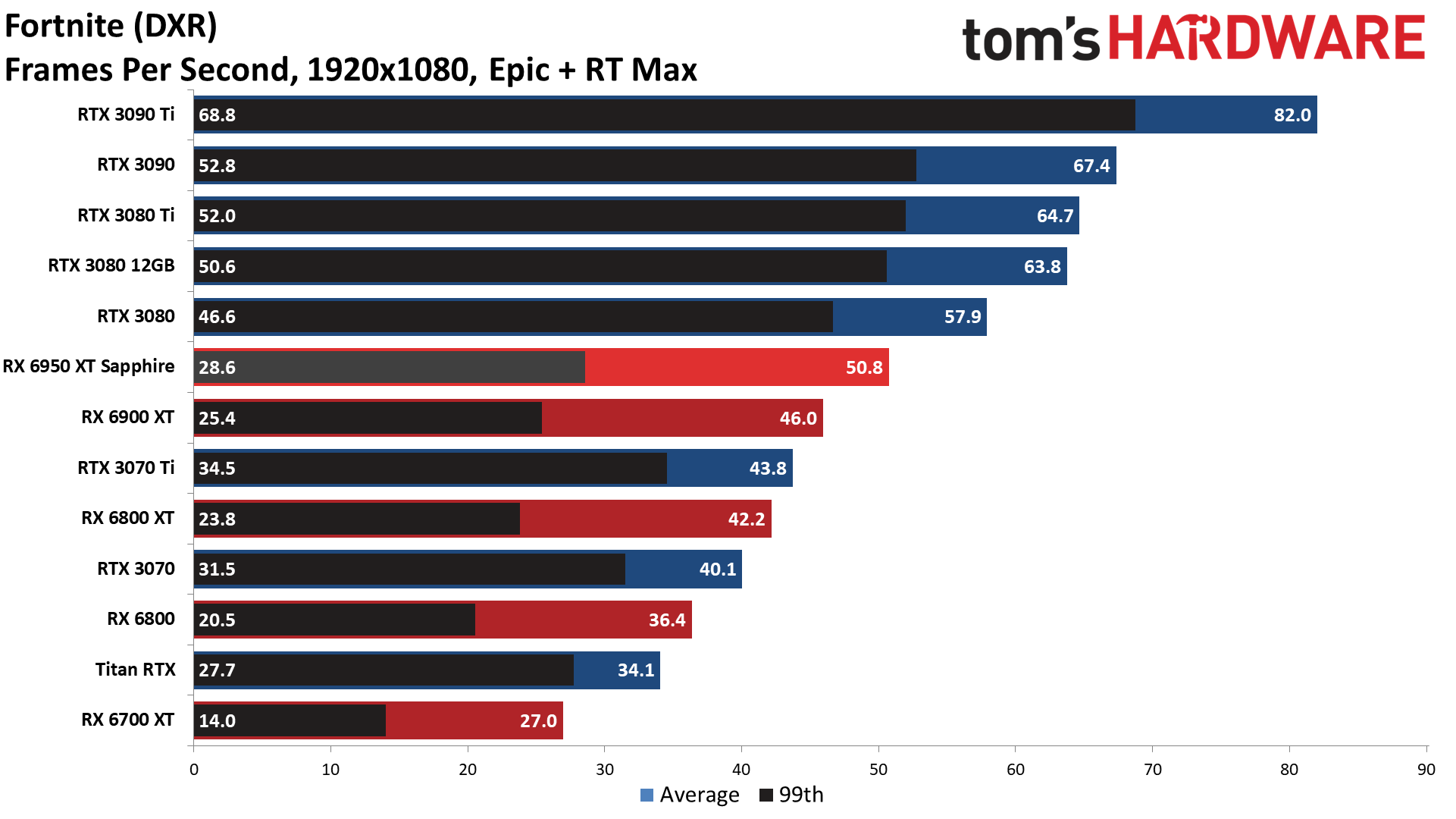
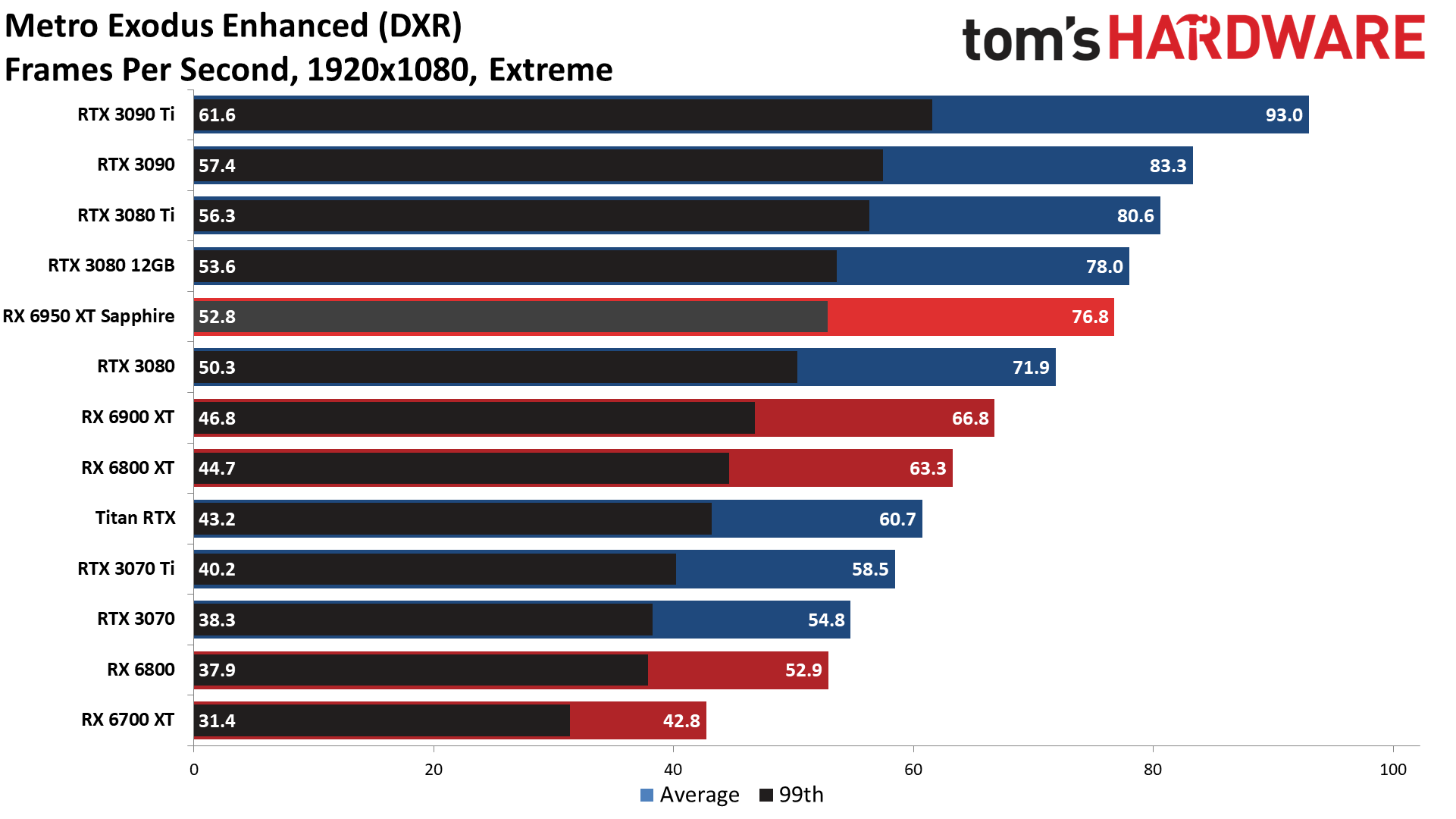
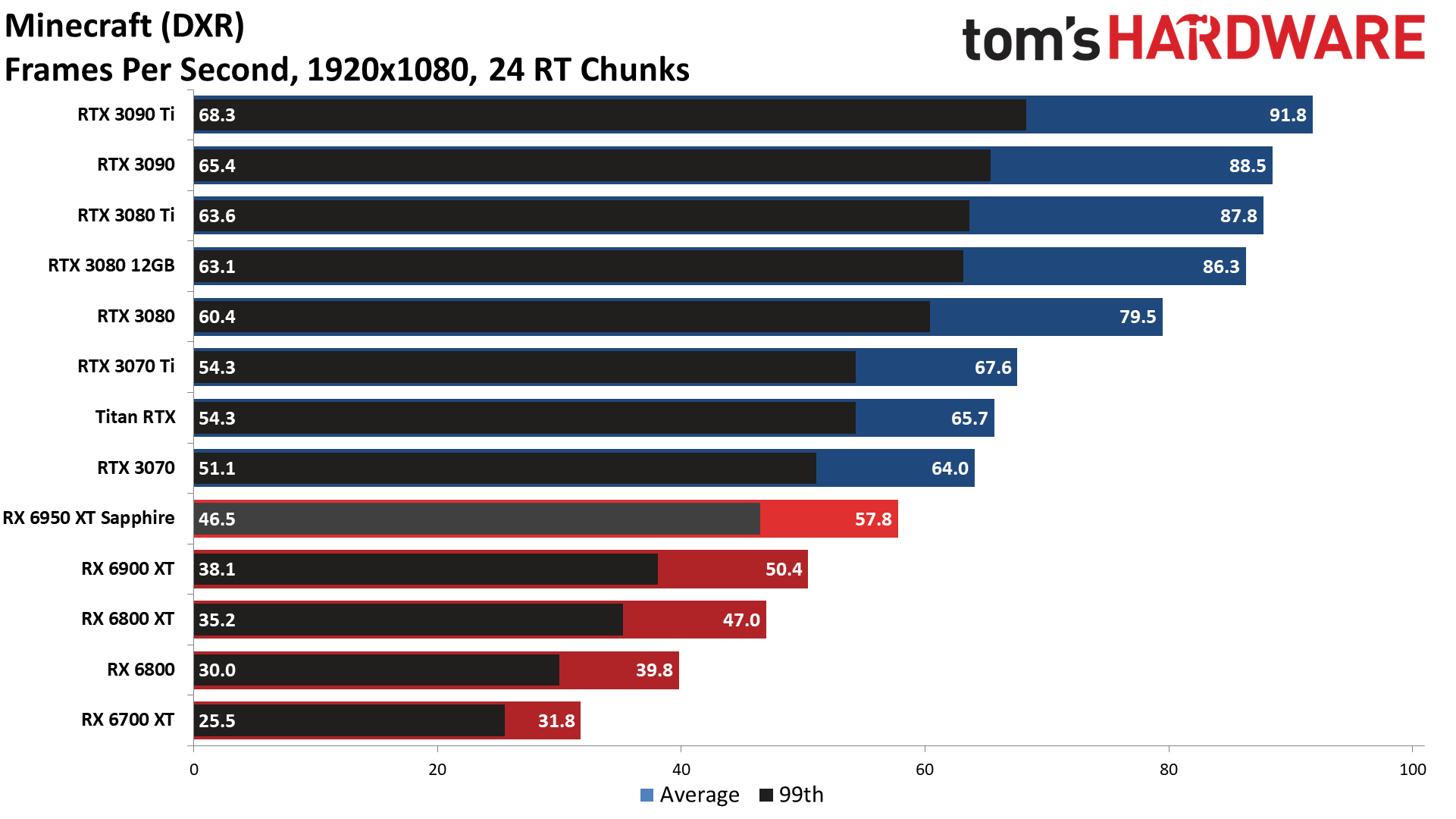
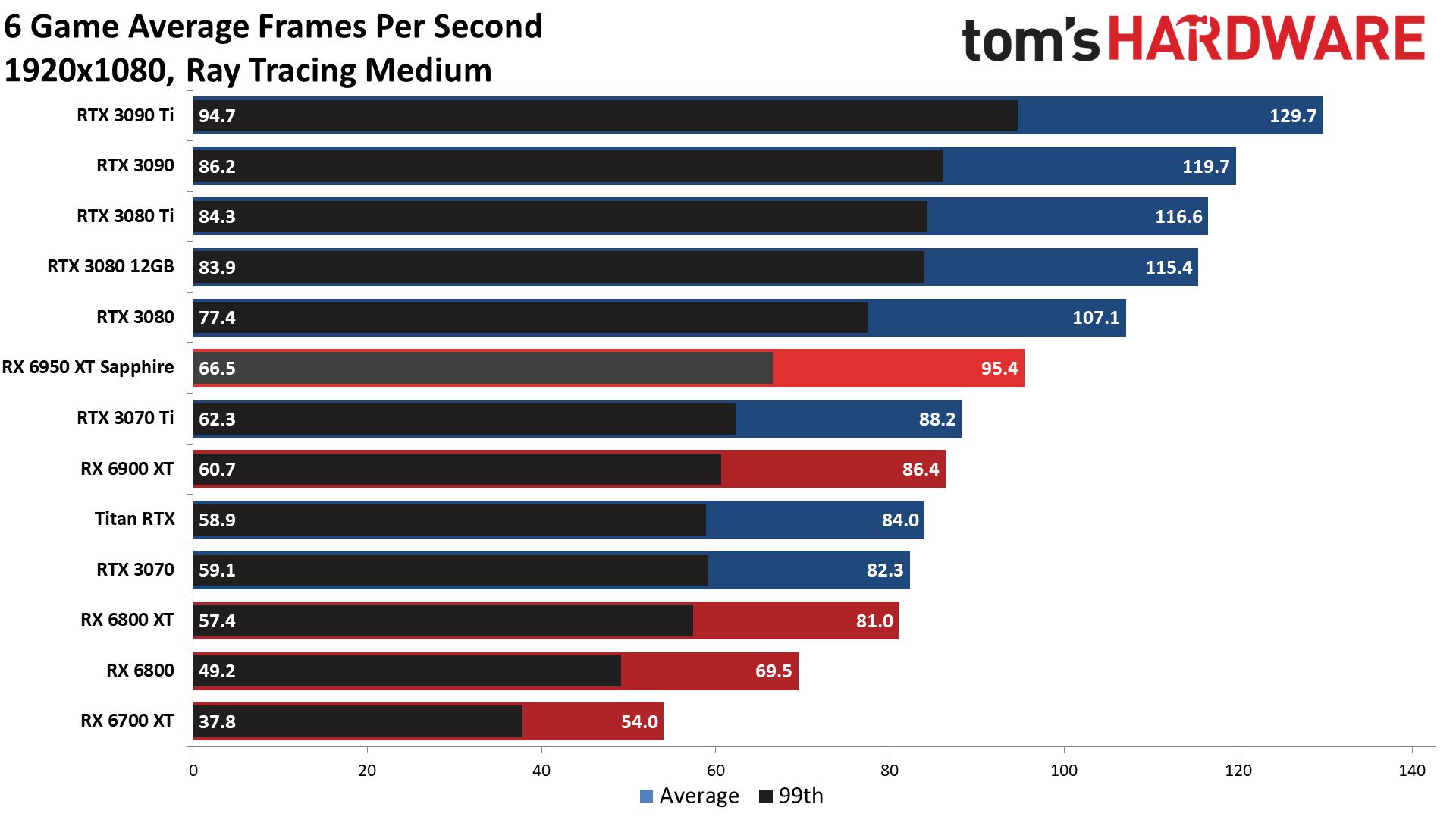
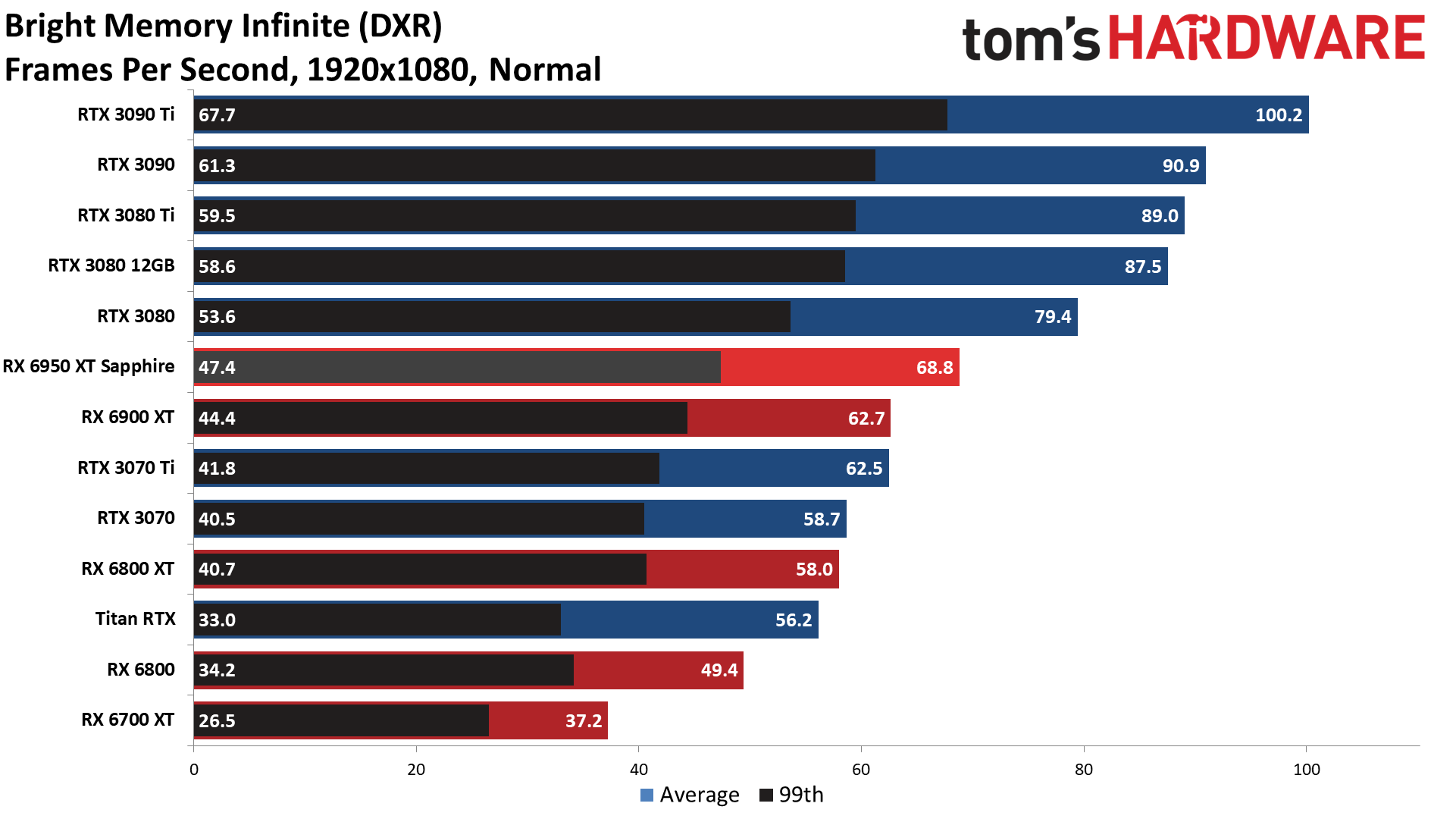
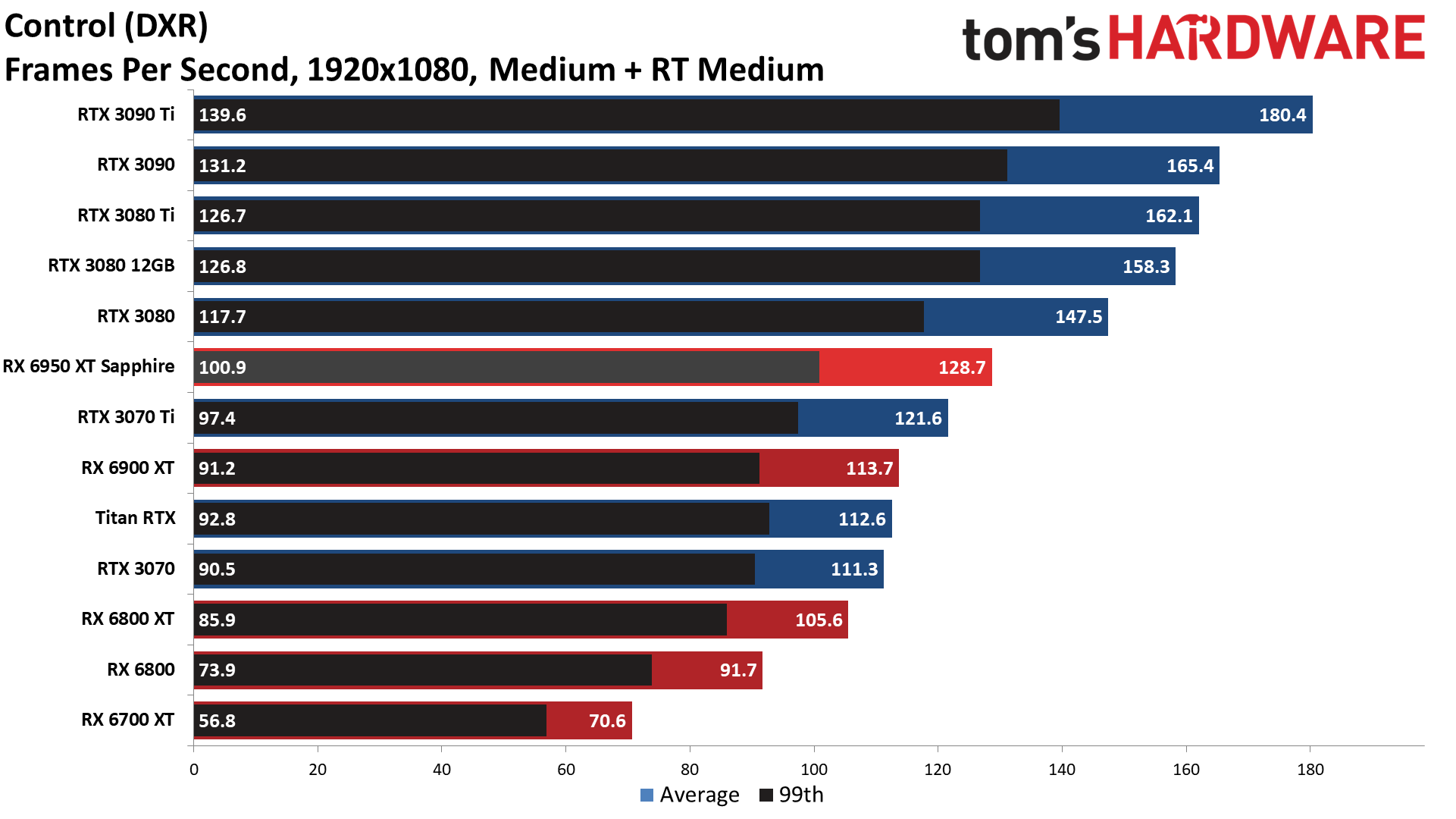
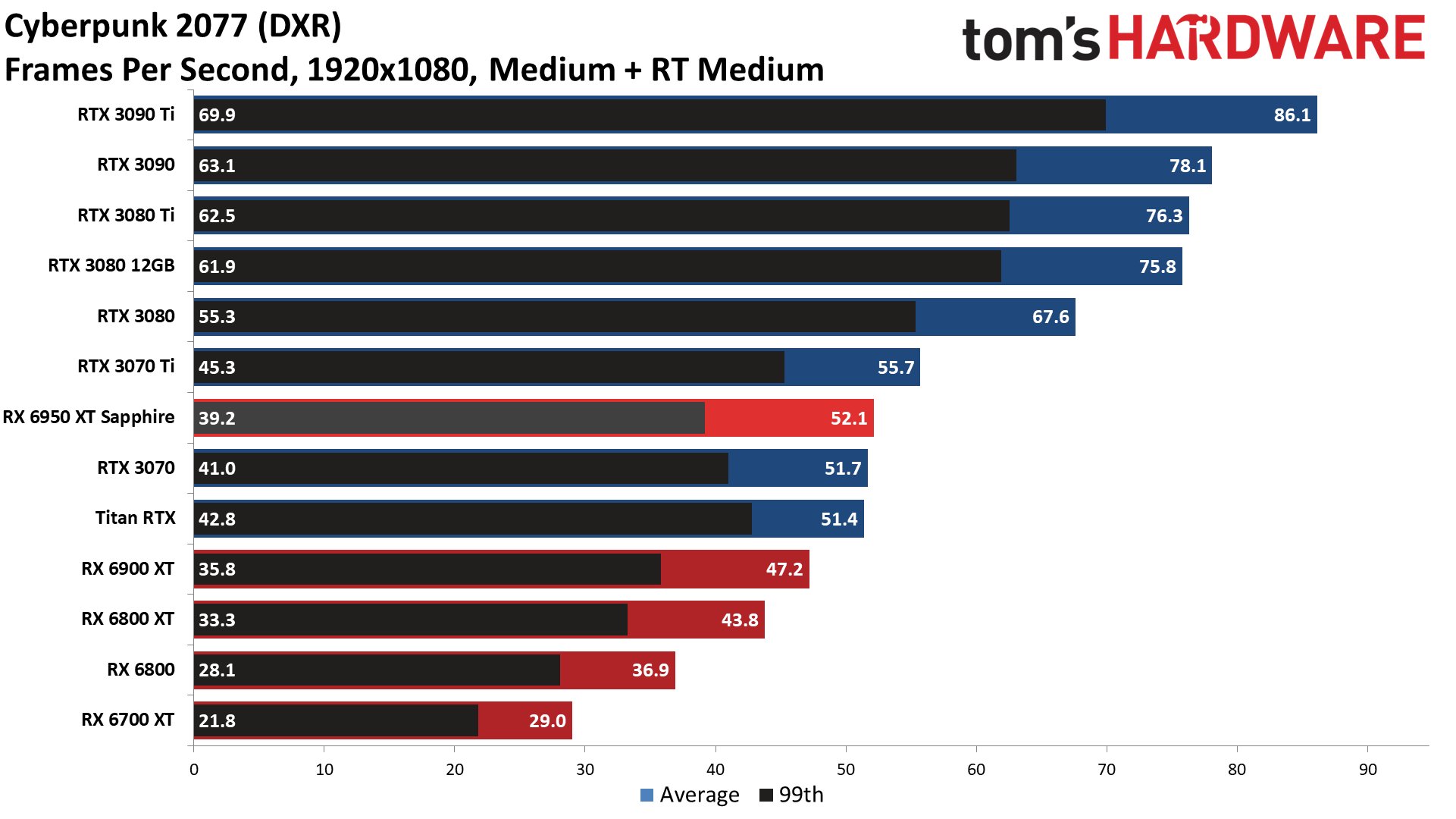
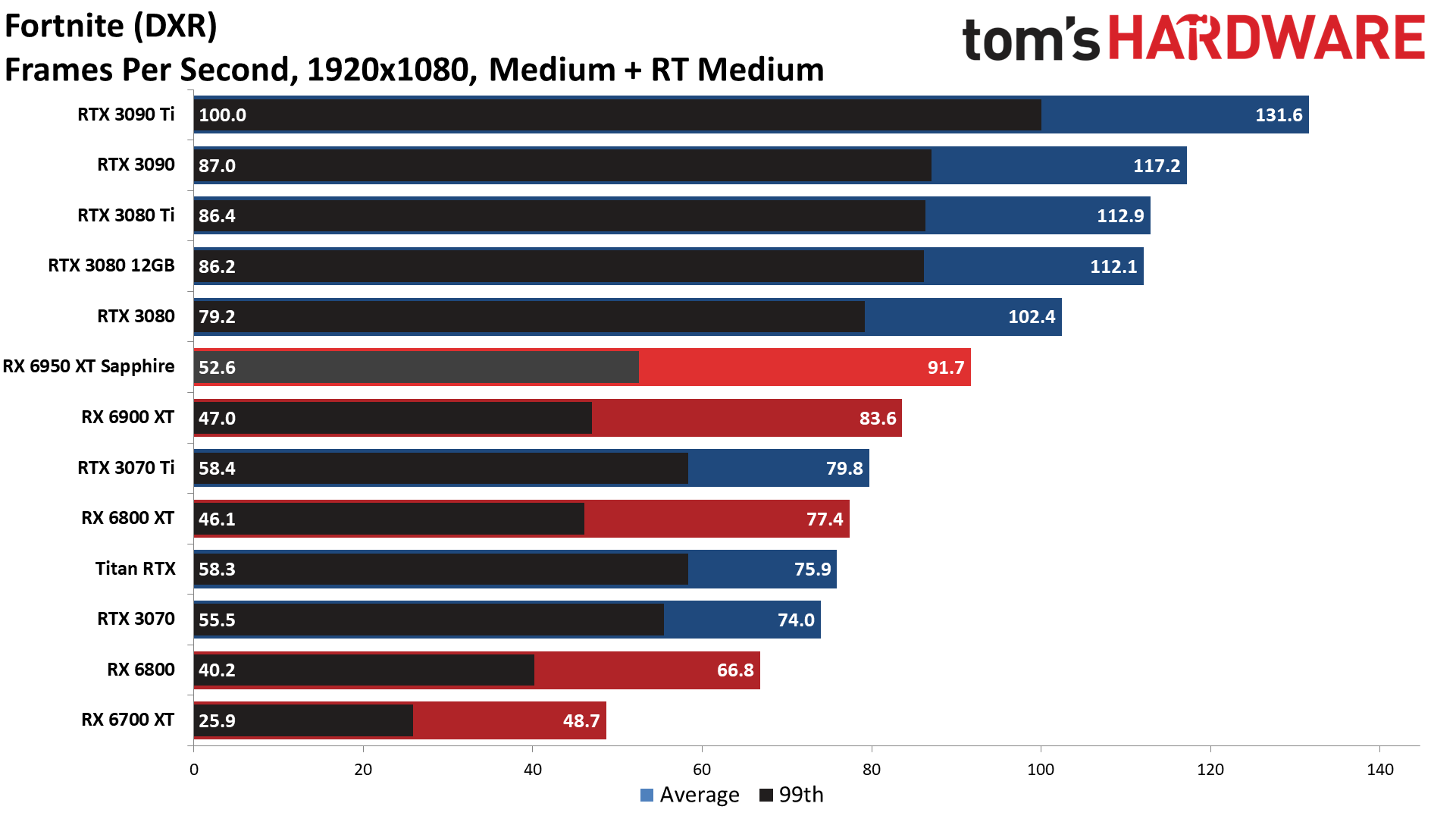
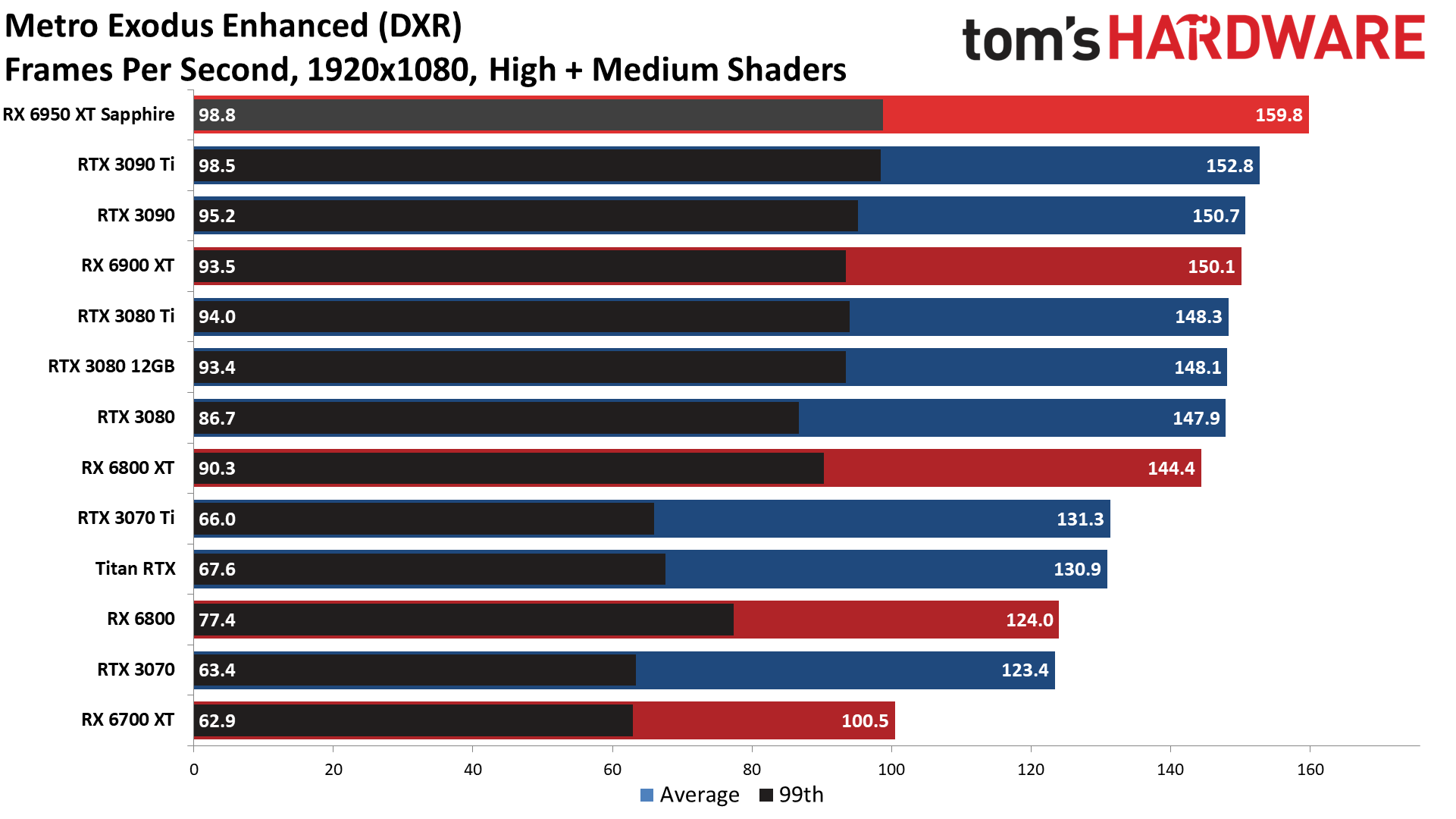
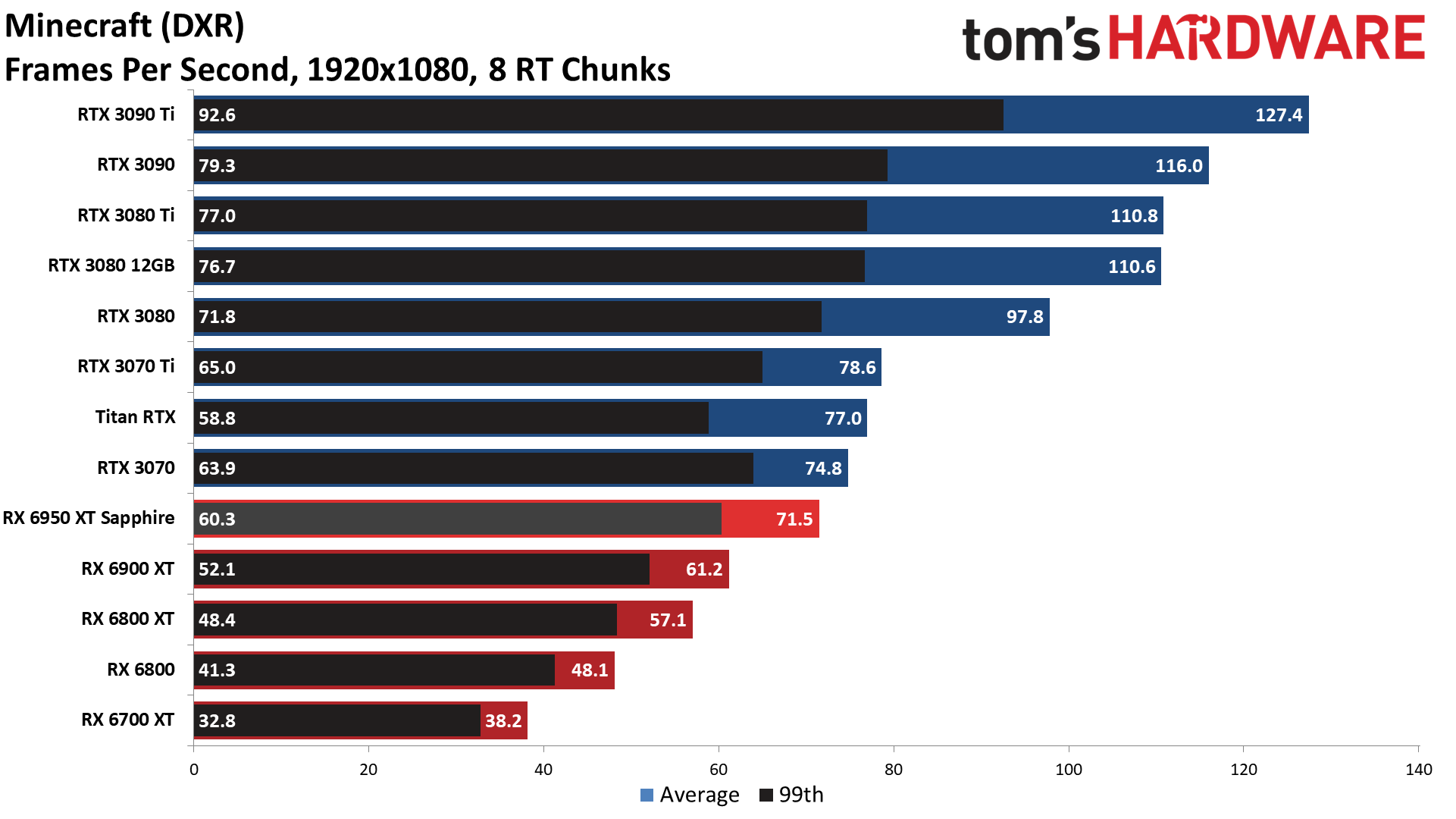
DXR remains demanding, however, though we have both Ultra and Medium DXR results this time. At 1080p ultra, the RX 6950 XT averaged more than 60 fps overall, but four of the games still dropped below that mark. The only reason for the higher average is thanks to Control and Metro Exodus Enhanced, which came in at 85 fps and 77 fps, respectively.
1080p medium with medium DXR effects at least finally gets most of our DXR suite above 60, though Cyberpunk 2077 still fell to 53 fps. AMD's ray accelerators are basically around half as fast as the RT cores in Nvidia's Ampere GPUs, and while AMD enjoys much higher clock speeds, it also doesn't have BVH traversal acceleration hardware. Plenty of gamers still do just fine playing everything without ray tracing, but if you want to enable all the RT effects, Nvidia easily wins. AMD's fastest GPU lands between the RTX 3070 Ti and RTX 3080, even with its VRAM advantage. There are even a few instances, like Minecraft, where the RTX 3070 came out ahead of the RX 6950 XT.
The big question is whether AMD will devote more hardware to ray tracing with RDNA 3. Unless Intel is hiding something, we don't expect Arc GPUs to offer much in the way of RT performance, considering even the top GPU will only have 32 RTUs compared to AMD's 80 ray accelerators. But perhaps Arc has similarities to Nvidia with the ability to compute more ray-triangle intersections per cycle and BVH hardware acceleration. We'll find out in a few months.
- MORE: Best Graphics Cards
- MORE: GPU Benchmarks and Hierarchy
- MORE: All Graphics Content
Get Tom's Hardware's best news and in-depth reviews, straight to your inbox.
Current page: Sapphire Radeon RX 6950 XT: 1080p Gaming Performance
Prev Page Sapphire Radeon RX 6950 XT: 1440p Gaming Performance Next Page Sapphire Radeon RX 6950 XT: Professional and Content Creation Performance
Jarred Walton is a senior editor at Tom's Hardware focusing on everything GPU. He has been working as a tech journalist since 2004, writing for AnandTech, Maximum PC, and PC Gamer. From the first S3 Virge '3D decelerators' to today's GPUs, Jarred keeps up with all the latest graphics trends and is the one to ask about game performance.
-
-Fran- Thanks for the review as always.Reply
I'm a bit puzzled with these refreshes... AMD wants just a little bit more money for them with equally little bit of extra performance, but in the case of the 6950XT and 6750XT, they are not replacing the "equivalent" card, so the potential "value" crumbles down horrendously. The 6650XT is a strange bug as it is meant to replace the 6600XT in the stack (or so I've read/seen) which, fair enough, seems like an "equivalent" replacement, maybe marginally better; just maybe. And still, overall, they don't seem like a refresh that had any significance of being launched right at this time.
The only silver lining I can totally see is the 6900XT and 6800XT going down the price stack significantly, maybe even pushing the already great 6800 closer to the 6750XT, making the latter completely pointless! Well, maybe not quite, but I'd say the 6800 is the go-get card in that price range if the prices adjust downward for the 6800. I wonder if this will push nVidia prices down? Historically it hasn't been the case, but maybe there's still a chance. I mention it, because the 3060ti is the sweet spot of this gen IMO, but if the 6800 goes down in price a bit more, its supremacy will be challenged. We all win regardless xD
Anyway, puzzling release to say the least after seeing the performance of the cards.
Regards. -
VforV Reply
RX 6800 was from the beginning and still is the least sold RDNA2 GPU in the entire line-up by AMD and now with the release of 6750 XT close to it's price and perf you can almost bet it will be MIA and never to be seen again.-Fran- said:The only silver lining I can totally see is the 6900XT and 6800XT going down the price stack significantly, maybe even pushing the already great 6800 closer to the 6750XT, making the latter completely pointless! Well, maybe not quite, but I'd say the 6800 is the go-get card in that price range if the prices adjust downward for the 6800. I wonder if this will push nVidia prices down? Historically it hasn't been the case, but maybe there's still a chance. I mention it, because the 3060ti is the sweet spot of this gen IMO, but if the 6800 goes down in price a bit more, its supremacy will be challenged. We all win regardless xD -
-Fran- Reply
Because the 3060ti and 3070 are just better cards at the price point; well, at MSRP. The 6800 I like because of the VRAM and its potential longevity, but for the "right now", the 3060ti is just the card to get around that price range IMO. That can change with the 6800 going down as I said. If that happens, then the 6750XT will be rendered irrelevant.VforV said:RX 6800 was from the beginning and still is the least sold RDNA2 GPU in the entire line-up by AMD and now with the release of 6750 XT close to it's price and perf you can almost bet it will be MIA and never to be seen again.
If you have the option to buy a 3070, 3060ti, 6750XT or a 6800 at around the same price, I'd be willing to say* rational thinkers would take the 6800.
Regards. -
VforV Reply
I did not contradict you on the appeal of the RX 6800, I just said you mostly never found this GPU available compared to others and from now on it will be even less available to non-existent... That's all that I said.-Fran- said:Because the 3060ti and 3070 are just better cards at the price point; well, at MSRP. The 6800 I like because of the VRAM and its potential longevity, but for the "right now", the 3060ti is just the card to get around that price range IMO. That can change with the 6800 going down as I said. If that happens, then the 6750XT will be rendered irrelevant.
If you have the option to buy a 3070, 3060ti, 6750XT or a 6800 at around the same price, I'd be willing to say* rational thinkers would take the 6800.
Regards.
It does not matter how good a product is if you can't buy it. -
-Fran- Reply
Well, since you started by saying it was the "least sold RDNA2 card" it confused me slightly. But I will disagree that is not found anywhere. At least now it is available in a lot of places at a more reasonable price. Kind of. Maybe in the USA it is selling rather too well or they provide less of them, but in the EU it is sold and in stock almost everywhere and has been for a good while. Looking back when they launched, the 6800 and 6800XT where the ones always out of stock and the 6900XT overpriced to the moon, then the 6900XT went to 6800XT territory (when I bought it) and now they're all close to their respective MSRPs over here, where the 6900XT is down juuuust a tiny bit.VforV said:I did not contradict you on the appeal of the RX 6800, I just said you mostly never found this GPU available compared to others and from now on it will be even less available to non-existent... That's all that I said.
It does not matter how good a product is if you can't buy it.
I will agree with the 6800 is going to become really scarce now, maybe more than before, when it drops further in price if it gets squeezed from above.
All in all, I find it strange you said it's the least sold card form the line up. I would say the 6700XT is the least sold? I've never seen it out of stock xD
Regards. -
artk2219 Huh, this is the first time in a long time that AMD has almost held the gaming performance crown, were it not for those 4k or ray tracing results this would be a bit of an upset, I want to say the last time they held the crown was with the R9 290X? Personally I don't care about the ray tracing results since in my opinion the performance in general just isn't there to actually have it enabled all the time, and 4k needs more cache to work well. In general RDNA2 has impressed me, and it really shows the potential that RDNA3 holds, next year should be pretty exciting times in the GPU market, well, so long as you can continue to pick one up at least somewhat affordably.Reply -
JarredWaltonGPU Reply
In the US, the RX 6800 has been in relatively short supply and the price has been significantly marked up for basically ever. At present, retail prices are roughly as follows:-Fran- said:Well, since you started by saying it was the "least sold RDNA2 card" it confused me slightly. But I will disagree that is not found anywhere. At least now it is available in a lot of places at a more reasonable price. Kind of. Maybe in the USA it is selling rather too well or they provide less of them, but in the EU it is sold and in stock almost everywhere and has been for a good while. Looking back when they launched, the 6800 and 6800XT where the ones always out of stock and the 6900XT overpriced to the moon, then the 6900XT went to 6800XT territory (when I bought it) and now they're all close to their respective MSRPs over here, where the 6900XT is down juuuust a tiny bit.
I will agree with the 6800 is going to become really scarce now, maybe more than before, when it drops further in price if it gets squeezed from above. All in all, I find it strange you said it's the least sold card form the line up. I would say the 6700XT is the least sold? I've never seen it out of stock xD
RX 6700 XT: $500
RX 6750 XT: $550
RX 6800: $760
RX 6800 XT: $800
RX 6900 XT: $950
RX 6950 XT: $1,100 (but sold out everywhere)
In terms of performance, the RX 6800 is 25-30% faster than the RX 6700 XT, because it has 50% more CUs and 33% more memory and memory bandwidth. Again, if it were in stock at the $580 MSRP, it would be quite compelling, but when the 6800 XT is only $40 more it's the better choice: 5% more money for 15% more performance.
Based on sales on eBay, the RX 6700 XT has been one of AMD's most popular RDNA 2 GPUs. In the past year, nearly 10,000 have been sold on eBay, compared to only 2,250 RX 6800 cards, 3,700 RX 6800 XT cards, and 2,800 RX 6900 XT cards. The 6600 XT is catching up, having sold over 6,300 since launch, but it hasn't gotten there yet. I know eBay isn't the retail market, but that's as good as I can do with the data that's out there.
Alternatively, the Steam Hardware Survey (DirectX 12 API page) shows 0.30% for the RX 6600 XT, 0.25% for the 6700 XT, 0.15% for the 6900 XT and RX 6600, 0.13% for the RX 6800 XT, 0.09% on the 6500 XT, and 0.05% for the RX 6800. So in that case the 6600 XT has surpassed the 6700 XT in total sales to gamers, maybe.
I don't think AMD will totally halt RX 6800 sales, but it has always been a GPU that only exists to take care of yields. If a Navi 21 isn't at least 90% functional on the CUs, and fully functional on the cache and memory controllers, it can't be sold as a 6800 XT. I do wonder if some Navi 21 chips end up as RX 6700 / RX 6750 XT, just because there will inevitably be flaws in the Infinity Cache or memory controllers. But perhaps AMD just doesn't bother with such chips. -
-Fran- Reply
I like the eBay numbers with one asterisk: if they've moved more 6700XTs than the rest of the line up, then maybe they made way way more Navi 22's than Navi 21's... Then again the combined number of 6800-series (Navi 21) and 6700XTs sold are not that far away from each other, so it could very well be that the total amount of each Navi chip sold was similar, but Navi 21 had worse yields (which makes total sense, as it is a bigger die), so the 6800-series were selling on all fronts about the same amount as AMD was able to put them in the market. I think that's a reasonable conclusion to draw from that data?JarredWaltonGPU said:In the US, the RX 6800 has been in relatively short supply and the price has been significantly marked up for basically ever. At present, retail prices are roughly as follows:
RX 6700 XT: $500
RX 6750 XT: $550
RX 6800: $760
RX 6800 XT: $800
RX 6900 XT: $950
RX 6950 XT: $1,100 (but sold out everywhere)
In terms of performance, the RX 6800 is 25-30% faster than the RX 6700 XT, because it has 50% more CUs and 33% more memory and memory bandwidth. Again, if it were in stock at the $580 MSRP, it would be quite compelling, but when the 6800 XT is only $40 more it's the better choice: 5% more money for 15% more performance.
Based on sales on eBay, the RX 6700 XT has been one of AMD's most popular RDNA 2 GPUs. In the past year, nearly 10,000 have been sold on eBay, compared to only 2,250 RX 6800 cards, 3,700 RX 6800 XT cards, and 2,800 RX 6900 XT cards. The 6600 XT is catching up, having sold over 6,300 since launch, but it hasn't gotten there yet. I know eBay isn't the retail market, but that's as good as I can do with the data that's out there.
Alternatively, the Steam Hardware Survey (DirectX 12 API page) shows 0.30% for the RX 6600 XT, 0.25% for the 6700 XT, 0.15% for the 6900 XT and RX 6600, 0.13% for the RX 6800 XT, 0.09% on the 6500 XT, and 0.05% for the RX 6800. So in that case the 6600 XT has surpassed the 6700 XT in total sales to gamers, maybe.
I don't think AMD will totally halt RX 6800 sales, but it has always been a GPU that only exists to take care of yields. If a Navi 21 isn't at least 90% functional on the CUs, and fully functional on the cache and memory controllers, it can't be sold as a 6800 XT. I do wonder if some Navi 21 chips end up as RX 6700 / RX 6750 XT, just because there will inevitably be flaws in the Infinity Cache or memory controllers. But perhaps AMD just doesn't bother with such chips.
As for the Steam Survey. I mentioned this in the news report where the 6900XT finally appeared in it. I've had it for a good while now and I've never seen the Steam Survey pop. Same with my laptop and its 6800M. I've swapped my CPU 3 times now and I've only been survey'd once; before I even got my Vega64 to replace my RX480. All of this to just point out and reinforce the point that the Steam Survey is weird.
Interesting information none the less, so thanks for it.
Regards. -
jacob249358 Man AMD is going to take over intel and Nvidia it seems. $1100 6950xt matching or beating the $2000 something 3090ti? WOW Ryzen 7000 is supposed to slap, rx 7000 is supposed to be absolutely insane with better efficiency than rtx 4000. It is a good time for the PC world.Reply -
Exploding PSU Of course they have a new model right after I bought a 6800XT.Reply
Well, at least I hope this will help push the price down even more.
